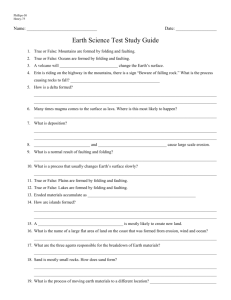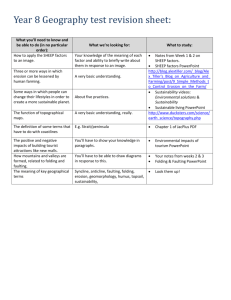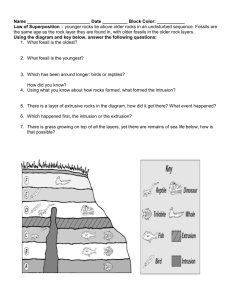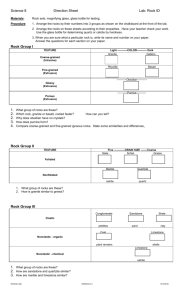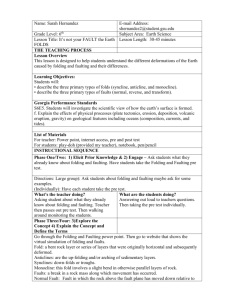GEOLOGY 101 - Chris Condit
advertisement
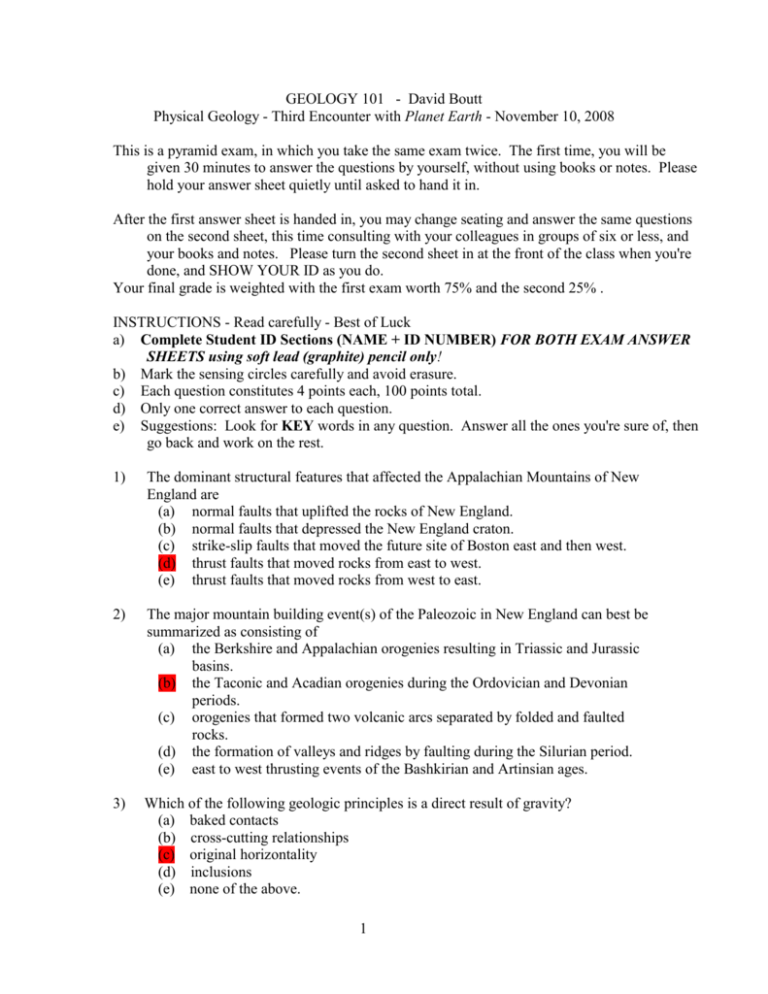
GEOLOGY 101 - David Boutt Physical Geology - Third Encounter with Planet Earth - November 10, 2008 This is a pyramid exam, in which you take the same exam twice. The first time, you will be given 30 minutes to answer the questions by yourself, without using books or notes. Please hold your answer sheet quietly until asked to hand it in. After the first answer sheet is handed in, you may change seating and answer the same questions on the second sheet, this time consulting with your colleagues in groups of six or less, and your books and notes. Please turn the second sheet in at the front of the class when you're done, and SHOW YOUR ID as you do. Your final grade is weighted with the first exam worth 75% and the second 25% . INSTRUCTIONS - Read carefully - Best of Luck a) Complete Student ID Sections (NAME + ID NUMBER) FOR BOTH EXAM ANSWER SHEETS using soft lead (graphite) pencil only! b) Mark the sensing circles carefully and avoid erasure. c) Each question constitutes 4 points each, 100 points total. d) Only one correct answer to each question. e) Suggestions: Look for KEY words in any question. Answer all the ones you're sure of, then go back and work on the rest. 1) The dominant structural features that affected the Appalachian Mountains of New England are (a) normal faults that uplifted the rocks of New England. (b) normal faults that depressed the New England craton. (c) strike-slip faults that moved the future site of Boston east and then west. (d) thrust faults that moved rocks from east to west. (e) thrust faults that moved rocks from west to east. 2) The major mountain building event(s) of the Paleozoic in New England can best be summarized as consisting of (a) the Berkshire and Appalachian orogenies resulting in Triassic and Jurassic basins. (b) the Taconic and Acadian orogenies during the Ordovician and Devonian periods. (c) orogenies that formed two volcanic arcs separated by folded and faulted rocks. (d) the formation of valleys and ridges by faulting during the Silurian period. (e) east to west thrusting events of the Bashkirian and Artinsian ages. 3) Which of the following geologic principles is a direct result of gravity? (a) baked contacts (b) cross-cutting relationships (c) original horizontality (d) inclusions (e) none of the above. 1 4) The relative time scale of geological events (a) is useful only for the last million years. (b) is more of an educated guess than being based on observations. (c) was originally based on radioactive measurements. (d) has been confirmed by radioactive dating. (e) none of these answers. 5) Examine the sequence of geologic events in block diagram below. The numbers correspond to the units (for example, limestone = 1, lowest shale = 2, lowest sandstone = 3, middle shale = 4, etc. (See the screen in front of the room for a color version). From oldest (first) to youngest, which is most nearly correct? (a) deposition of units 1, 2, 3, 4, 5, 6, 7, intrusion of granite, folding, faulting, intrusion of basalt dike (b) deposition of units 1, 2, 3, 4, 5, 6, 7, folding, intrusion of granite, normal faulting, intrusion of basalt dike (c) deposition of units 1, 2, 3, 4, 5, 6, 7, intrusion of granite, folding, intrusion of basalt dike, faulting (d) deposition of units 1, 2, 3, 4, 5, 6, 7, folding, intrusion of granite, reverse faulting, intrusion of basalt dike. (e) deposition of units 7, 6, 5, 4, 3, 2, 1, folding, intrusion of granite, normal faulting, intrusion of basalt dike. 2 6) Radiometric ages for the igneous rocks are: Sill = 230 m.y., Granite 130 m.y., basalt dike = 50 m.y. How closely can you estimate the time of faulting? (a) between 230 m.y. and 130 m.y. (b) between 130 m.y. and 50 m.y. (c) between 230 m.y. and 50 m.y. (d) younger than 50 m.y. (e) older than 230 m.y. 7) Pieces of unit 5 appear in the sill. What geologic principle is applied to determine that unit 5 is older than the sill? (a) principle of inclusions (b) principle of baked contacts (c) principle of original horizontality (d) principle of cross-cutting relations (e) principle of geologic origins 8) The Himalayan Mountain Range of Asia is believed to have originated by (a) vast outpouring of fluid basaltic lavas. (b) massive igneous intrusions into this part of the crust. (c) collision of the Indian-Australian plate with the mainland of Asia. (d) large-scale block faulting. (e) folding of an island arc. 9) An episode of mountain building is termed a(n) _____ (a) slickenside. (b) orogeny. (c) aureole. (d) convergence. (e) structural confluence. 3 10) The age sequence in this block diagram of folded sedimentary rocks starts with the oldest unit labeled unit 7, the youngest bed is unit 4. What kind of a structure is this feature? (a) Anticline (b) Syncline (c) Monocline (d) Homocline (e) Thermocline 11) In which direction is the structure shown in the above question plunging? (a) West (b) East (c) North (d) None of these (e) South 12) The Connecticut Valley represents a pull-apart basin that resulted from (a) a failed continental rift that formed when the Iapetus Ocean opened. (b) gremlins tugging at the lithospheric fabric beneath a bankrupt state. (c) faulting during the Paleozoic. (d) a mid-oceanic ridge which now extends through Norway. (e) a failed continental rift that formed when the Atlantic Ocean opened. 13) Which of the following lists contains only fossil fuels? (a) coal, oil, natural gas (b) coal, geothermal, wind (c) coal, wood, natural gas (d) hydroelectric, geothermal, wind (e) U-235, oak, wind 4 14) The Earth is approximately how old? (a) 15 billion years (b) 4.6 billion years (c) 40 million years (d) 6,000 years 15) The Hadean is a time in Earth history when _____. (a) the first abundant shelly organisms appear in the fossil record (b) Earth's interior was so hot that a solid outer crust, if present, was likely being extensively remelted (c) stable continental interiors, termed cratons, first formed (d) the dinosaurs first appeared and came to dominate large-scale terrestrial life 16) Towards the end of the Archean eon, _____. (a) the first abundant shelly organisms appear in the fossil record. (b) Earth's interior was so hot that a solid outer crust, if present, was likely being extensively remelted (c) stable continental interiors, termed cratons, first formed (d) the dinosaurs first appeared and came to dominate large-scale terrestrial life 17) The greatest depth at which oil is found is about _____. (a) 1 km below the surface (b) approx. 6.5 km below the surface (c) at the Moho (d) the base of the lithosphere (e) 100 m 18) Which of the following is a renewable resource? (a) coal (b) oil (c) wind (d) natural gas (e) uranium 19) Deformation brought on by orogeny _____. (a) can metamorphose rock (b) can produce folds in rock (c) can produce faulting in rock (d) All of the above are produced by orogeny. 20) In a undisturbed sequence of sedimentary rocks, younger layers overly older layers, according to the principle of _____. (a) superposition (b) original continuity (c) original horizontality 5 (d) uniformitarianism 21) Water promotes mass wasting by: (a) lubricating rock (b) adding weight (c) weakening grain bonds (d) expanding soils (e) all of these 22) Which of the following types of mass movement takes place most gradually? (a) slump (b) creep (c) rock slide (d) mudflow 23) Which of the following types of mass movement is least coherent (most like a liquid)? (a) slump (b) creep (c) rock slide (d) mudflow 24) The stereotypical gold rush prospector panning for gold in a stream bed is an example of exploiting _____. (a) magmatic deposits (b) placer deposits (c) residual mineral deposits (d) sedimentary deposits (e) all of these answers. 25) If the half-life of a radioactive decay scheme is 1.5 million years, and a rock has 25% remaining parent, the age of the rock is (a) 3 m.y. (b) 0.75 m.y. (c) 5 m.y. (d) 1.5 m.y. (e) can't tell from the data. 6
